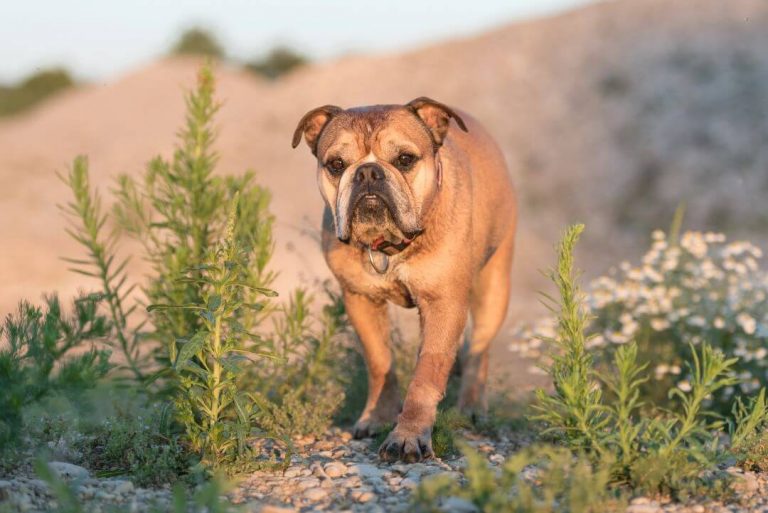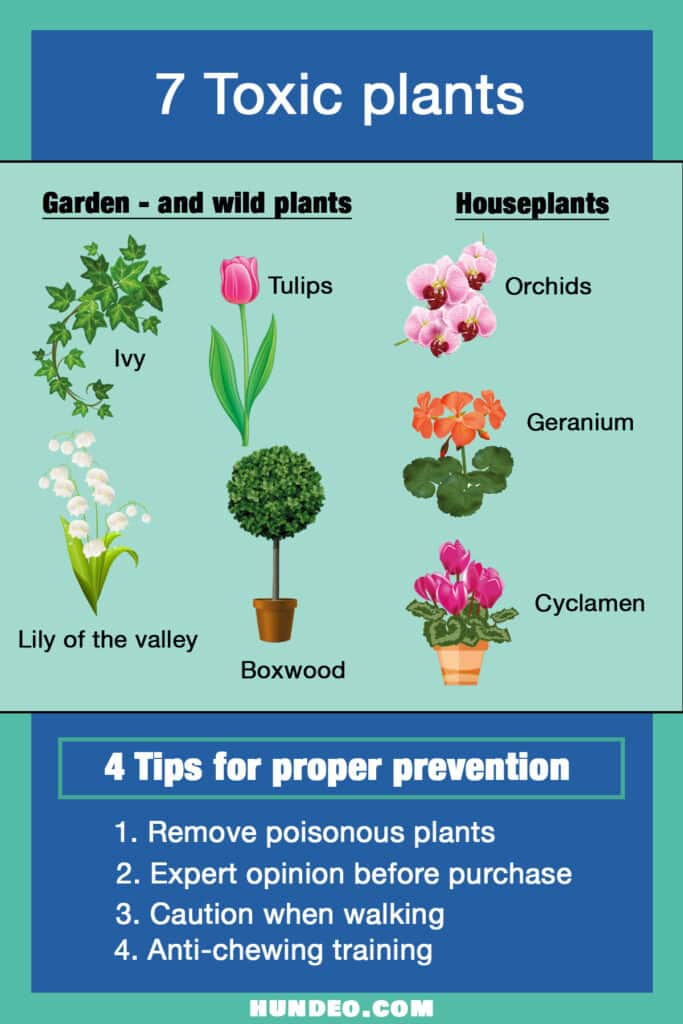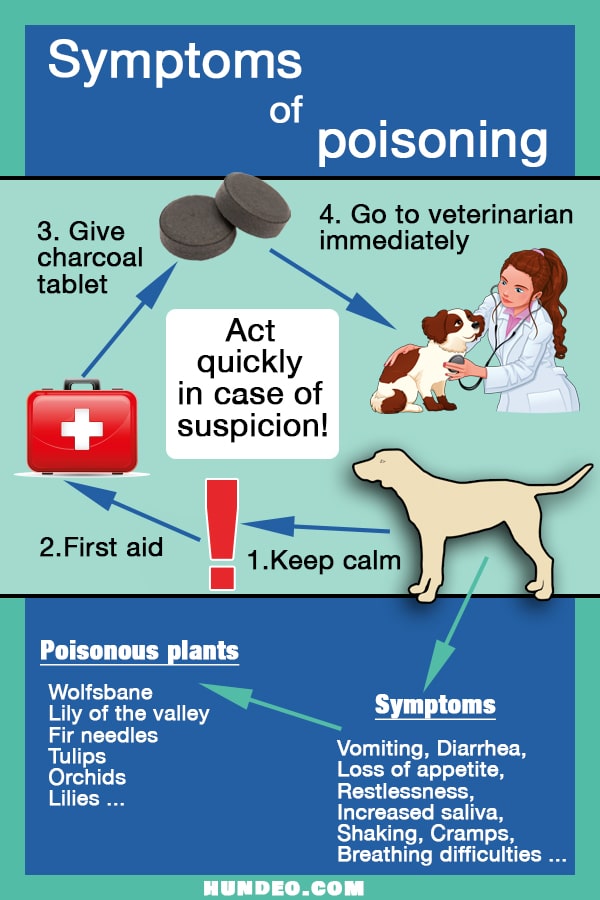70 Poisonous plants for dogs and what you can do in case of emergency
- Veterinarian Mag.med.vet. Emin Jasarevic
- Updated: April 6, 2023
In this guide you will find an overview of plants that are toxic to our dogs. Also, for this article we have obtained advice from the veterinarian Mag.med.vet. Emin Jasarevic caught up. So be curious.

Plants: They beautify our home or garden with beautiful flowers and stately leaves, while providing a soothing indoor environment.
But unfortunately, you have to be careful when they are within reach of our dogs. Because many of our houseplants can be poisonous to them. Especially puppies and young dogs are affected by this.
They explore their new world with nose and mouth and of course find plants extremely interesting. So they sniff around, lick and also nibble.
List of poisonous garden and wild plants
You can find these plants in gardens or in the wild. Even if you don't have them in your own garden, you should look out for them when you go for a walk. They grow, especially on the side of the road or in meadows.
- Blue monkshood
- Brunfelsie
- Boxwood
- Wood anemone
- Datura
- Ivy
- Yew
- Monkshood
- Angel Trumpet
- Foxglove
- Honeysuckle
- Golden Rain
- Autumn crocus
- Hydrangea
- Hyacinths
- Cherry Laurel
- Lily of the Valley
- Mistletoe
- Oleander
- Passionflower
- Rhododendron
- Delphinium
- Hemlock
- Fir needles
- Thuja
- Belladonna
- Tulips
- Juniper
- Cedar
- and others
List of poisonous houseplants
If possible, these plants should not be in the same room as your four-legged friend. If you can't part with some of them, they should be placed out of reach.
- Agave
- Cyclamen
- Amaryllis (Delphinium)
- Aralie
- Azalea
- Bow hemp (bayonet plant)
- Variegated leaf
- Christ thorn, Christ star
- Chrysanthemum
- Clivie
- Dieffenbachia
- Dragon tree, dragon lily
- Monocle
- Elephant tree
- Window leaf
- Ficus (rubber tree) and other species of ficus
- Flamingo flower
- Geranium
- Sweetheart
- Piston thread
- Lilies, all types
- Orchids, all species
- Philodendron
- Poinsettia
- and others
The list includes only the most famous poisonous house and garden plants and is by no means complete. With the enormous variety of flowers, shrubs and other plants, it is impossible to list them all.
Therefore, unless you are 100 % sure that the plant is harmless, it must be gone or out of reach of your charge.

Cherry laurel, boxwood, hogweed, ...
The number of poisonous plants is extremely high. So it is impossible to describe each one in detail. Nevertheless, I would like to introduce you to a few that you should pay special attention to.
" Cherry Laurel became the Poisonous plant of the year appointed. And not without reason: this plant is very poisonous and (unfortunately) also widespread. Indeed, it is often used as an evergreen hedge. Even if it looks beautiful, its poison is very potent. So when you go for a walk, it's better to give it a wide berth.
" Boxwood contains very many different poisons. This mixture makes it one of the most poisonous plants in our regions. Basically, everything on the tree is poisonous: leaves, bark, flowers, fruits... So it's best to banish it from your garden and pay special attention to it when walking.
At Hogweed many disagree about whether it is poisonous to dogs or not. This is due to the fact that only certain varieties can be dangerous.
The small meadow hogweed is harmless to our four-legged friends. In contrast, however, the giant hogweed is very poisonous.
One touch is enough. You can recognize it by the fact that it is at least 1.50 m high. Nevertheless, you should also be careful with smaller plants, because the giant hogweed also has to grow first. A "younger" specimen can therefore also be a growing giant hogweed.
When instinct is not enough
Many people think that dogs instinctively know which plants they can eat and which plants are poisonous. Therefore, they do not think about possible poisonous plants in their house or garden.
This was also the case with the ancestors of our faithful companions, the wolves. However, due to taming and centuries of breeding, many of these original instincts are no longer as pronounced as they once were.
In addition, we often import our current house and garden plants from other countries. Therefore, they are no longer very similar to the former "wild" plants.
So it can quickly happen that your pet nibbles on plants that are poisonous for him. So do not rely too much on the instincts of your favorite, but remove all poisonous plants before they arouse his interest.
This is how poisoning can occur
Dogs can ingest the poison of a plant in different ways. It depends on what kind of poisonous plant it is.
The most common type of recording is via the Mouth. This happens, for example, when your on the leaves, flowers or root of the plant. nibbles.
Many dogs do this out of boredom, curiosity or simply because the flower smells so interesting. Sometimes plant parts are also Completely swallowed.
Unfortunately, it is particularly dangerous when the toxin enters the stomach. From there, it can then quickly spread throughout the body.
For some plants is enough already the Skin contactto transfer the toxin. This is the case, for example, with hogweed.
In particularly rare cases, the Inhale of the poison lead to symptoms. However, the poisoning is not as strong and dangerous with these types of ingestion as with ingestion via the mouth.
Symptoms of Poisoning
With a Poisoning by a plant can cause versatile symptoms, because each poison acts differently. However, there are some symptoms that occur in most poisonings.
The first reaction of the body after poisoning is largely Vomiting or Diarrhea. This should quickly bring the poison out of the body. But unfortunately, in this case it is already too late. It has already been partially or completely absorbed into the blood.
Your protégé probably realizes himself that something is wrong with him. He then seems very restless and runs back and forth. But some toxins also cause Paralysis symptoms and Apathy.
Poisoning is often accompanied by a increased saliva production associated with. In extreme cases, this is recognizable by the foam in front of the mouth. Other symptoms are Abdominal pain and Loss of appetite.
Blood in vomit, feces or urine are also a sign of poisoning. In addition, most poisons after a while cause Circulatory problems, Trembling, Cramps and Respiratory problems.
If the poisoning is already very advanced and has not been treated, it can even lead to Organ Failures or to the Respiratory arrest come.
Here you will find a summary of the most important symptoms:
- Vomiting
- Diarrhea
- Abdominal pain
- Loss of appetite
- Unrest
- Apathy
- Paralysis symptoms
- increased saliva production
- Blood in vomit, feces or urine
- Circulatory problems
- Trembling
- Cramps
- Respiratory problems
- Respiratory arrest
- Organ failure

In case of suspicion: Act quickly!
If some of the above-mentioned symptoms appear in your pet, there is no time to lose. As long as the poison has not been absorbed, i.e. is not in the blood, the doctor can help your protégé by making him vomit with medication. You should not try to do this yourself, as there is a danger of suffocation.
For some poisons there are antidotes, for many unfortunately not. In most cases, after ingestion of poison and severe symptoms of poisoning, the dog must be given intravenous infusion fluid for a long time. It then flushes the toxins out of the body as quickly as possible.
Therefore, you should go to the vet even if you only suspect that your pet has eaten a poisonous plant. Do not wait until the first symptoms appear. Then it could already be too late.
1. keep calm
Poisoning can have serious consequences, there is no question about that. But it does no one any good if you get into a hectic state. So stay calm and think about what to do next.
In this way, there will be no rash actions and you will calm your protégé at the same time. Because the last thing he needs right now is excitement.
2. first aid
If the poisoning is already advanced and your faithful companion is unconscious, you should give first aid. Put him in the recovery position and keep checking his pulse and breathing.
Be prepared to perform resuscitation in an emergency.
3. give charcoal tablets
Charcoal tablets (also called activated charcoal) bind the poison in the gastrointestinal tract, thus rendering it ineffective, and are then excreted with the feces. However, they are only effective if not much time has passed since the poison was ingested.
Once the toxin has entered the blood, charcoal tablets can no longer prevent the poisoning.
Every dog owner should have activated charcoal in the house for emergencies. Beforehand, it is best to discuss with a veterinarian how many tablets should be given in case of poisoning.
4. immediately to the vet
As soon as you suspect that your four-legged friend has eaten a poisonous plant, you should immediately take him to a veterinarian. Find out beforehand whether the vet is open. If necessary, take your pet to a veterinary clinic.
The veterinarian should be informed about the emergency in advance, preferably by telephone. Then he can prepare for it and have the appropriate medication ready.
If the poisoning is already advanced, your little one may not be able to walk. Then you should quickly organize help for the transport to the vet or animal hospital.
The problem with plant poisoning is that each poison acts differently and therefore requires a different antidote or therapy.
Therefore, you should tell the doctor your suspicions about the type of poisoning as well as the amount ingested.
Also, tell him in detail about all the symptoms. If possible, you should even bring the poisonous plant with you.
If your protégé is treated quickly, the chances of survival increase enormously. Therefore: If you suspect poisoning, act as quickly as possible!
Mushrooms are taboo for dogs
Even though mushrooms are not plants, I mention them here anyway.
Indeed, many dog owners make a serious mistake: they think that harmless Food for humans are also safe for their four-legged friends.
However, just by looking at the example of Chocolate it becomes clear that many more foods are toxic to dogs than to us.
This also applies to mushrooms. Not enough research has been done on which mushrooms are really toxic for them and which are not. For this reason, four-legged friends should not eat mushrooms to be on the safe side. This also means that they should be kept out of reach in the kitchen or garden.
4 tips for proper prevention
1. remove all poisonous plants
Check all your houseplants and garden plants to see if they are toxic to your furbearer. If so, you should remove them immediately, give them away, or at least put them out of your dog's reach.
Of course, the list of poisonous plants is not complete. Even a book about plants cannot list all the poisonous plants in the world. Therefore, in case of doubt: What is not one hundred percent harmless, must be removed.
2. expert opinion before buying a plant.
If you want to buy a new plant at the florist or garden center, you should inform yourself about it beforehand. For this purpose, you can, among other things, ask the adviser in the store whether this houseplant or garden plant is safe for four-legged friends.
3. be careful when walking
Poisonous plants lurk not only in the room or in the garden. The most dangerous ones are probably found on roadsides or meadows. That's why you should keep an eye on the flowers and bushes on the path and not get too close to "suspicious" ones. This way, your furry companion won't have the chance to get poisoned while walking.
4. anti nibble training
Of course, contact with plants cannot be completely avoided. That's why it makes sense to teach your pet from the very beginning that he must not nibble on unknown things or plants. Once he has learned this, you no longer have to be afraid of poisoning by plants during a walk.
Frequently Asked Questions
Lily of the valley, tulips, ivy and boxwood are among the most common poisonous garden and wild plants. Poisonous houseplants are orchids, geraniums or cyclamen. You can find a comprehensive list of poisonous plants for dogs in our article.
It's best to get rid of all poisonous plants from your living area and garden. You should also train your dog to stop nibbling on plants when you ask him to do so.
There are very many different symptoms that a poisoned dog can have. They range from vomiting, tremors and diarrhea to unconsciousness. Read our article carefully to learn about all the possible symptoms.
First, you need to keep a calm head. Take your dog to the vet as soon as possible. You can give him an activated charcoal tablet beforehand. If possible, take the poison, stool or vomit from your dog to the vet.
It all depends on the poison, the dose and your dog. Not every poisoning is fatal, but it is always an emergency. The chances for your protégé are higher, the faster he is treated by a veterinarian.
Veterinarian’s Recommendation
Poisoning can have serious consequences for your pet and in the worst case lead to death. Therefore, it is especially important for dog owners to prevent this case and to react correctly in an emergency.
Very many plants are poisonous for our dogs. Therefore, they have nothing to look for in the house or garden of dog owners. It is best to check all your plants and consistently dispose of poisonous plants. Even the ones you are not sure about. When walking, be aware of possible poisonous plants and keep your faithful companion away from them.
Even despite all caution, poisoning can occur. In this case, it is important to remain calm and act quickly. If symptoms have not yet appeared, charcoal tablets can prevent worse.
In any case, your dog must be taken to the vet as soon as possible. If you act quickly, you can save your pet's life.

I am a veterinarian and writer on animal health topics. Animals are my passion, and it is my personal goal to create medically accurate articles and videos to educate pet owners as much as possible.
Share Now:

